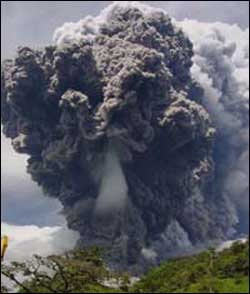Rare volcanic plumes create uncommonly dangerous ash flows

Plume of Volcán Reventador
Three unique photographs of a recent volcanic eruption in a remote part of Ecuador show a plume unlike any previously documented, and hint at a newly recognized hazard, say scientists at the University of Illinois at Urbana-Champaign.
“The usual volcanic plume consists of a stalk capped with an umbrella, and resembles the mushroom of an atom bomb blast,” said geology professor Susan Kieffer, “but the umbrella on this plume was wavy, like the shell of a scallop.”
In a paper scheduled to appear March 15 in the journal Geophysical Research Letters, Kieffer, theoretical and applied mechanics professor Gustavo Gioia, and graduate student Pinaki Chakraborty explain what might have caused the umbrella to scallop, a task made more difficult by the scarcity of information.
“We had never seen a scalloped umbrella before,” said Kieffer, who holds a Charles R. Walgreen Jr. Chair at Illinois. “Unusual conditions must have existed in the volcanic plume that formed this umbrella.”
Located about 100 kilometers from Quito, Ecuador, Volcán Reventador — Spanish for “one that explodes” — lived up to its name on the morning of Nov. 3, 2002. Following seven hours of seismic activity and billowing steam, the summit cone exploded and sent a stream of ash, called a pyroclastic flow, several kilometers down nearby valleys. While traveling close to the ground, the ash heated the surrounding air, which became buoyant as in a hot-air balloon. The air rose in a volcanic plume, carrying the ash with it.
“A volcanic plume rises until the atmosphere becomes so thin that the mixture of air and ash loses buoyancy and starts to spread laterally, forming an umbrella,” Gioia said. “The umbrella spreads and cools for a long time before the ash begins to fall gradually.”
But instead of the usual hot ash, the Reventador eruption appears to have been laden with steam and a fairly cool ash from the destruction of the summit cone. The unusually cool umbrella could not spread for a long time. It rapidly became a heavy mixture of air, steam and ash hovering precariously over the lighter air below.
“When a heavier fluid is placed on top of a lighter one, you might say that the fluids want to be reversed,” said Chakraborty, the paper’s lead author. “The ensuing tug of war between gravity and the viscosity of the fluids results in a wavy instability that pulls the heavier fluid on a fast sinking course.”
In laboratory experiments, the fluids are initially at rest, and the wavelength of the instability is a fraction of an inch. But the mixture of air, steam and ash in the Reventador umbrella was turbulent, with many fast, locally swirling motions.
“Turbulence magnifies the wavelength,” Chakraborty said. “It gave the Reventador umbrella its distinctive scallops, which were hundreds of meters in wavelength.”
While most umbrellas produce gradual ash falls, scalloped umbrellas behave differently and might represent a previously unrecognized hazard.
“Our analysis suggests that the Reventador umbrella collapsed rapidly, forming new and especially dangerous ash flows,” said Kieffer, who is also a professor in the university’s Center for Advanced Study, one of the highest forms of campus recognition.
Originating far from the summit cone, these new ash flows must have helped spread the damage caused by the eruption. They must have been uncommonly energetic, because the ash fell from the umbrella, which was 10 kilometers high.
“For all we know, these flows were responsible for broken petroleum pipelines,” Chakraborty said. “The flows might also have contributed to the early phases of a shutdown of Quito airport that lasted more than a week.”
Media Contact
More Information:
http://www.uiuc.eduAll latest news from the category: Earth Sciences
Earth Sciences (also referred to as Geosciences), which deals with basic issues surrounding our planet, plays a vital role in the area of energy and raw materials supply.
Earth Sciences comprises subjects such as geology, geography, geological informatics, paleontology, mineralogy, petrography, crystallography, geophysics, geodesy, glaciology, cartography, photogrammetry, meteorology and seismology, early-warning systems, earthquake research and polar research.
Newest articles

Superradiant atoms could push the boundaries of how precisely time can be measured
Superradiant atoms can help us measure time more precisely than ever. In a new study, researchers from the University of Copenhagen present a new method for measuring the time interval,…

Ion thermoelectric conversion devices for near room temperature
The electrode sheet of the thermoelectric device consists of ionic hydrogel, which is sandwiched between the electrodes to form, and the Prussian blue on the electrode undergoes a redox reaction…

Zap Energy achieves 37-million-degree temperatures in a compact device
New publication reports record electron temperatures for a small-scale, sheared-flow-stabilized Z-pinch fusion device. In the nine decades since humans first produced fusion reactions, only a few fusion technologies have demonstrated…





















